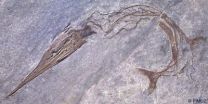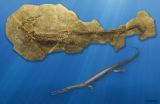(Press-News.org) 252 million years ago the largest extinction event occurred at the end of the Permian age. It wiped out almost 90 percent of all life in water. So far researchers had assumed that the ecosystems gradually recovered from this catastrophe over a long stretch of eight to nine million years and that large predators at the uppermost end of the food chain were the last to reappear. A Swiss-American team of palaeontologists headed by Torsten Scheyer and Carlo Romano from the University of Zurich demonstrate in their new study that the food nets during the Early Triassic did not recover in stages. Large predators like, for instance, crocodile-like amphibians and later the precursors of the known plesiosaurs and ichthyosaurs went in search of prey in the oceans soon after the end of the mass extinction.
Large predators in on the action from the very start
Apex predators – large predators at the uppermost end of the food chain – are extremely important for the health and stability of an ecosystem. They eradicate sick and weak animals and exercise constant selection pressure on the species they prey on. Hence, Scheyer and his colleagues wanted to establish whether the apex predators really were missing from the oceans after the mass extinction and how the ecosystems functioned.
The researchers looked at the global distribution of predatory marine vertebrates and their body size in the Early and Middle Triassic and came to surprising conclusions. "The apex marine predators recovered after the large extinction over a very, comparatively short period of time", says Torsten Scheyer. The researchers were also able to refute a second theory. Earlier it had been assumed that marine predators grew continuously larger from the Early to the Middle Triassic culminating in the apex predators. "We now demonstrate that already in the Early Triassic large predators hunted in the seas", adds Carlo Romano."The length of the food chains was not shortened by the end-Permian mass extinction. Nor are there any signs of a gradual re-emergence of the classical trophic pyramids from the base to the top", explains Hugo Bucher. To gain greater understanding of food webs, attention had to be paid not only to the shape of the food webs but also to the dynamics, i.e. the evolutionary rates of the participating species.
New actors in old roles
The large end-Permian mass extinction led to a completely new composition of apex predators. Large predatory fish were dominant in the Permian age but they had to share this role with predatory crocodile-like amphibians after the mass extinction. Another extinction event around two million years later, the End Smithian crisis, triggered changes in the group of apex predators. From this point in time fish and for the first time reptiles like, for instance, Askeptosaurus were at the uppermost end of the food chains.
"The role of the large predators always remained the same in the ecosystems; only the actors changed over the course of time", comments Torsten Scheyer when summing up the new results. The researchers are convinced that insight into events in the past will contribute to better understanding of the impact of today's climate changes on ecosystems.
INFORMATION:
Literature:
Torsten M. Scheyer, Carlo Romano, Jim Jenks, Hugo Bucher. Early Triassic Marine Biotic Recovery: The Predators' Perspective. PLOS ONE, March 19, 2014. DOI: 10.1371/journal.pone.0088987
Contact:
Dr. Torsten Scheyer
Palaeontological Institute and Museum
University of Zurich
Tel. + 41 634 23 22
Email:tscheyer@pim.uzh.ch
Dr. Carlo Romano
Palaeontological Institute and Museum
University of Zurich
Karl Schmid-Strasse 4
CH 8006 Zürich
Amphibians and dinosaurs were the new large predators after the mass extinction
2014-03-20
ELSE PRESS RELEASES FROM THIS DATE:
Elsevier's Maturitas publishes position statement on menopause for medical students
2014-03-20
Amsterdam, March 20, 2014 – Elsevier, a world-leading provider of scientific, technical and medical information products and services, today announced the publication of a position statement by the European Menopause and Andropause Society (EMAS) in the journal Maturitas on the topic of the essential menopause curriculum for medical students.
The menopause, or the cessation of the menstrual cycle, is the result of ovarian aging and is a natural event experienced by most women in their late 40s or early 50s. With increasing longevity the menopause can now be considered ...
Shrink wrap used to enhance detection of infectious disease biomarkers
2014-03-20
WASHINGTON, March 20—Detecting HIV/AIDS, tuberculosis, malaria and other deadly infectious diseases as early as possible helps to prevent their rapid spread and allows for more effective treatments. But current detection methods are cost-prohibitive in most areas of the world. Now a new nanotechnology method—employing common, everyday shrink wrap—may make highly sensitive, extremely low-cost diagnosis of infectious disease agents possible.
The new technique, described in a paper published today in The Optical Society's (OSA) journal Optical Materials Express, offers ...
Inhibition of oral biofilm and cell-cell communication using natural-products derivatives
2014-03-20
Alexandria, Va., USA – Today during the 43rd Annual Meeting & Exhibition of the American Association for Dental Research, held in conjunction with the 38th Annual Meeting of the Canadian Association for Dental Research, Steve Kasper, SUNY College of Nanoscale Science and Engineering, Albany, will present research titled "Inhibition of Oral Biofilm and Cell-cell Communication Using Natural-products Derivatives."
Many plant metabolites and structurally similar derivatives have been identified as inhibitors of bacterial biofilm formation and quorum sensing (QS). Previously, ...
Research brings new control over topological insulator
2014-03-20
An international team of scientists investigating the electronic properties of ultra-thin films of new materials – topological insulators (TIs) - has demonstrated a new method to tune their unique properties using strain.
Topological insulators are new materials with surfaces that host a new quantum state of matter and are insensitive to contaminants, defects and impurities. Surface electrons in TIs behave like massless Dirac particles in a similar way to electrons in graphene. Moreover, surface currents in topological insulators also preserve their spin orientation and ...
E3-production -- sustainable manufacturing
2014-03-20
This news release is available in German.
Industrial manufacturing is pivotal to Germany's prosperity. Not only does manufacturing account for a quarter of GDP, it provides a third of jobs as well. Yet rising raw material and energy costs, coupled with a demographic shift, pose significant challenges for industry. Keeping manufacturing operations in Germany will require a fundamental shift away from maximum profit from minimal capital investment toward maximum added value from minimum resources.
Initiating and effecting this change is what Fraunhofer's E3-production ...
Resin infiltration effects in a caries-active environment -- 2 year results
2014-03-20
Alexandria, Va., USA – Today during the 43rd Annual Meeting & Exhibition of the American Association for Dental Research, held in conjunction with the 38th Annual Meeting of the Canadian Association for Dental Research, Mathilde C. Peters, University of Michigan, Ann Arbor, USA, will present research titled "Resin Infiltration Effects in a Caries-Active Environment – 2 Year Results."
The objective of this study was to compare carious lesion changes after resin infiltration of approximal non-cavitated lesions in a high caries risk population after two years. Resin infiltration ...
Thermal conductance can be controlled like waves using nanostructures
2014-03-20
Thermal conduction is a familiar everyday phenomenon. In a hot sauna, for instance, you can sit comfortably on a wooden bench that has a temperature of 100C (212F), but if you touch a metallic nail with the same temperature, you will hurt yourself. The difference of these two experiences is due to the fact that some materials, such as metals, conduct heat well, whereas some other materials, such as wood, do not. It is therefore commonly thought that thermal conductance is simply a materials parameter. Now, researchers at the University of Jyväskylä, Finland, led by Professor ...
Oldest fossil evidence of modern African venomous snakes found in Tanzania
2014-03-20
ATHENS, Ohio (March 19, 2014)—Ohio University scientists have found the oldest definitive fossil evidence of modern, venomous snakes in Africa, according to a new study published March 19 in the journal PLOS ONE.
The newly discovered fossils demonstrate that elapid snakes—such as cobras, kraits and sea snakes—were present in Africa as early as 25 million years ago, said lead author Jacob McCartney, a postdoctoral researcher in the Ohio University Heritage College of Osteopathic Medicine. He's part of a team that has been examining the Rukwa Rift Basin of Tanzania over ...
Surface of Titan Sea is mirror smooth, Stanford scientists find
2014-03-20
New radar measurements of an enormous sea on Titan offer insights into the weather patterns and landscape composition of the Saturnian moon. The measurements, made in 2013 by NASA's Cassini spacecraft, reveal that the surface of Ligeia Mare, Titan's second largest sea, possesses a mirror-like smoothness, possibly due to a lack of winds.
"If you could look out on this sea, it would be really still. It would just be a totally glassy surface," said Howard Zebker, professor of geophysics and of electrical engineering at Stanford who is the lead author of a new study detailing ...
Parents should try to find middle ground to keep teens safe online
2014-03-20
Parents might take a lesson from Goldilocks and find a balanced approach to guide their teens in making moral, safe online decisions, according to Penn State researchers.
In a study on parenting strategies and online adolescent safety, the researchers found evidence that suggests that parents should try to establish a middle ground between keeping their teens completely away from the internet not monitoring their online activities at all.
"It's a Goldilocks problem," said Pamela Wisniewski, a postdoctoral scholar in information sciences and technology. "Overly restrictive ...






